Veterinary Clinic Business Template & PDF Example
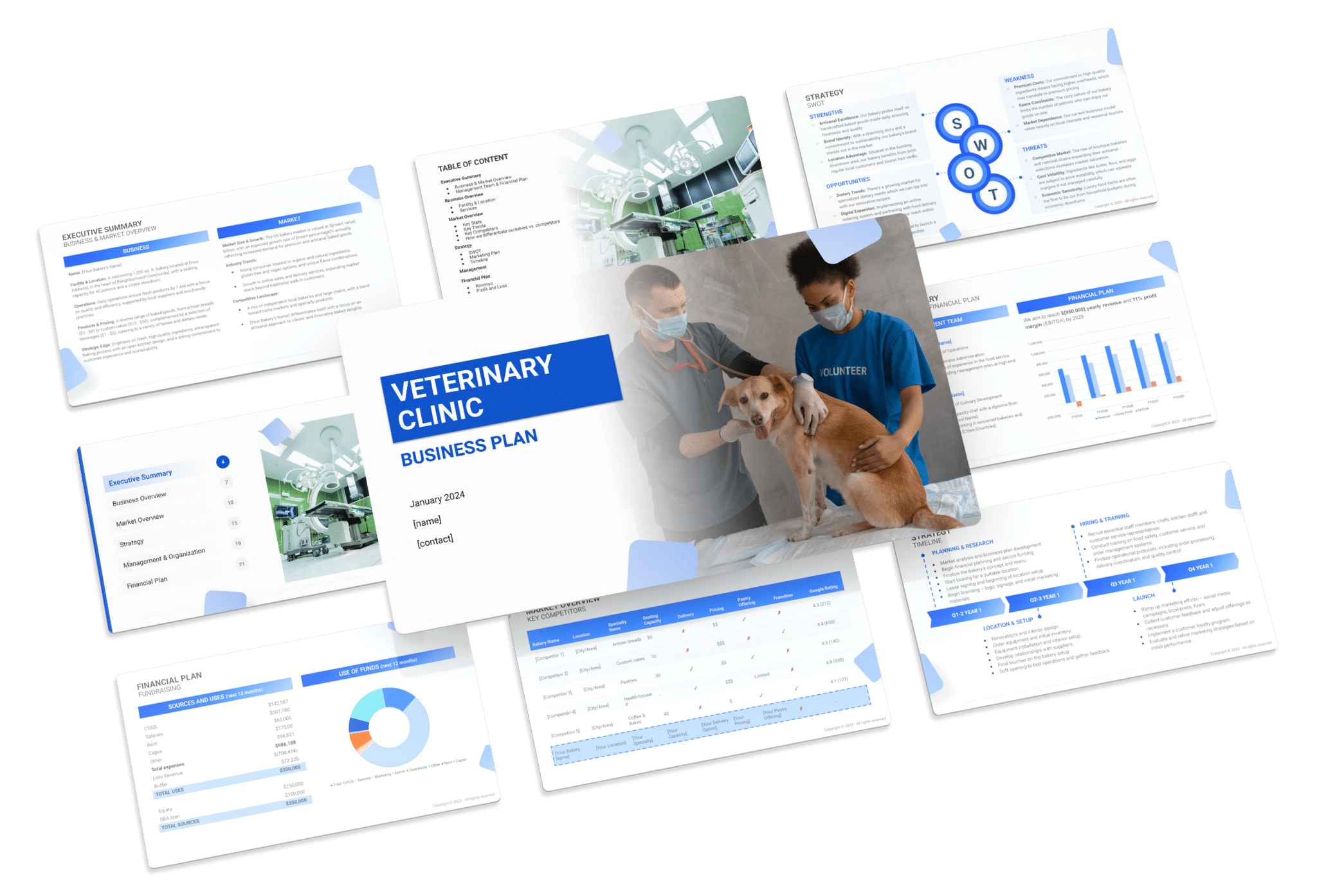
Creating a comprehensive business plan is crucial for launching and running a successful veterinary clinic. This plan serves as your roadmap, detailing your vision, operational strategies, and financial plan. It helps establish your veterinary clinic’s identity, navigate the competitive market, and secure funding for growth.
This article not only breaks down the critical components of a veterinary clinic business plan, but also provides an example of a business plan to help you craft your own.
Whether you’re an experienced entrepreneur or new to the pet industry, this guide, complete with a business plan example, lays the groundwork for turning your veterinary clinic concept into reality. Let’s dive in!
The Plan
Our veterinary clinic business plan is designed to encompass all critical elements required for a well-rounded strategic approach. It details the clinic’s operational procedures, marketing tactics, the veterinary market landscape, competitive analysis, management team structure, and financial projections.
- Executive Summary: Provides a concise overview of the Veterinary Clinic’s proposition, emphasizing a comprehensive range of veterinary services, market analysis showing the sector’s growth and demand, the expertise of the management in veterinary medicine and healthcare operations, and a financial strategy that outlines investment opportunities and revenue forecasts.
- Business Overview: Offers detailed insights into the Veterinary Clinic’s operational model:
- Clinic & Location: Describes the clinic’s state-of-the-art facility, designed to ensure a stress-free environment for pets and their owners, including examination rooms, surgical suites, and a retail section for pet care products.
- Services: Details the wide array of services offered, from general check-ups and vaccinations to specialized treatments and emergency care, aimed at providing comprehensive care for pets.
- Market Overview: Examines the veterinary services landscape, identifying key players and carving out the clinic’s unique niche:
- Key Stats: Presents data highlighting the market size, growth trends, and statistics that underscore the potential and necessity for veterinary services.
- Key Trends: Highlights significant trends such as the growing focus on specialized veterinary services, the adoption of telemedicine, and eco-friendly practices.
- Key Competitors: Analyzes the main competitors in the vicinity, their offerings, and how the clinic’s unique approach and services set it apart.
- Strategy: Outlines the clinic’s strategic plan for growth and establishing a robust market presence:
- SWOT Analysis: Conducts a comprehensive analysis of Strengths, Weaknesses, Opportunities, and Threats to strategically position the clinic.
- Marketing Plan: Details marketing strategies aimed at building brand visibility, attracting new clients, and retaining them through superior service, patient satisfaction programs, and targeted marketing efforts.
- Timeline: Sets forth key milestones and objectives from the clinic’s setup to its launch and key growth phases.
- Management: Highlights the experienced team leading the clinic, from veterinarians to administrative management, emphasizing their roles in ensuring high-quality care and clinic success.
- Financial Plan: Projects the financial outlook for the clinic over the next few years, detailing revenue models from various services, cost management strategies, profit margins, and expected return on investment, ensuring a clear route to financial sustainability and growth.

Executive Summary
The Executive Summary introduces your veterinary clinic’s business plan, offering a concise overview of your clinic and its services. It should detail your market positioning, the range of veterinary and pet care services you offer, its location, size, and an outline of day-to-day operations.
This section should also explore how your veterinary clinic will integrate into the local market, including the number of direct competitors within the area, identifying who they are, along with your clinic’s unique selling points that differentiate it from these competitors.
Furthermore, you should include information about the management and co-founding team, detailing their roles and contributions to the clinic’s success.
Additionally, a summary of your financial projections, including revenue and profits over the next five years, should be presented here to provide a clear picture of your clinic’s financial plan.
Veterinary Clinic Business Plan Executive Summary Example
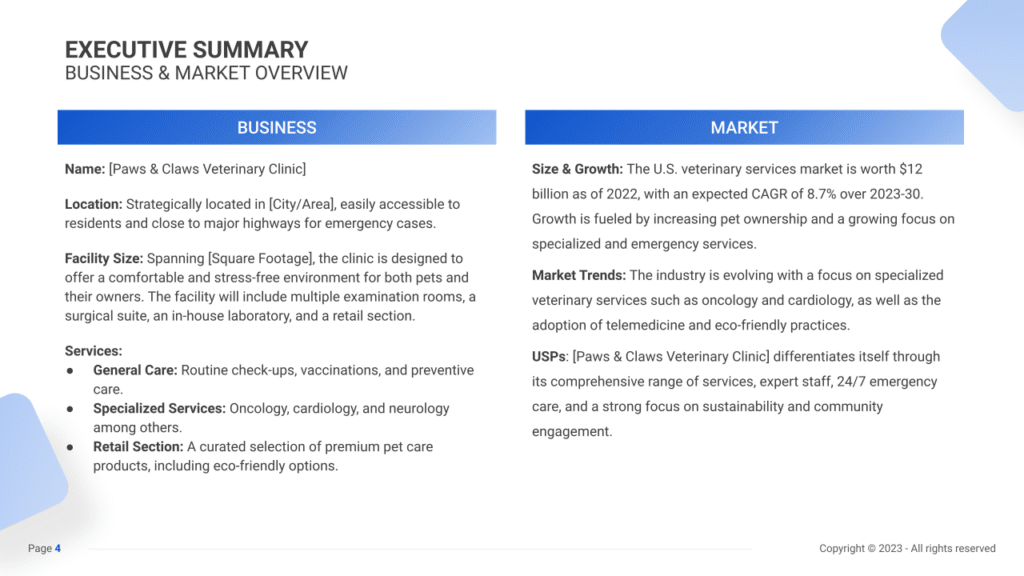
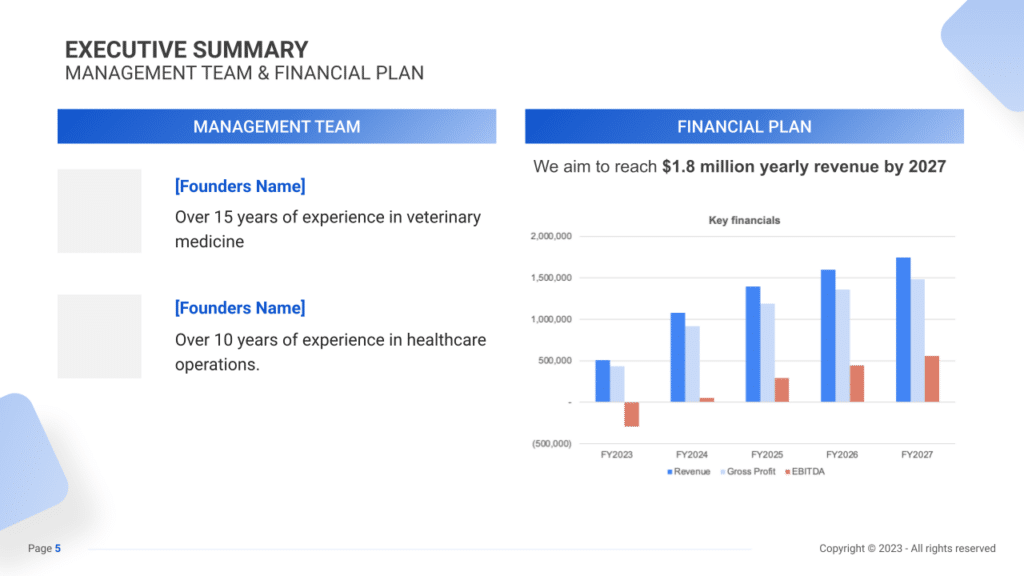
Business Overview
In the business overview, it’s important to detail the key attributes of your veterinary clinic, such as the name, location, facility features, and the range of veterinary services offered. Highlighting what sets your clinic apart in the veterinary market, like specialized services or sustainable practices, is crucial for drawing interest and investment.
Example:
“Paws & Claws Veterinary Clinic,” located in the bustling Midtown district, covers 4,000 square feet and is designed for the comfort of pets and their owners. The clinic includes advanced facilities like a surgical suite and an in-house lab, and offers services ranging from routine check-ups to specialized care in oncology and cardiology. A unique aspect of Paws & Claws is its retail section featuring eco-friendly pet products.
Market Overview
This section should analyze the veterinary market’s size, growth trends, and key industry developments. It helps position your clinic within the industry and underlines its potential to meet the evolving demands in veterinary care.
Example:
Paws & Claws Veterinary Clinic is entering a market valued at $12 billion, expected to grow at an 8.7% CAGR. The clinic stands out in a market that is increasingly seeking specialized veterinary services and innovative practices like telemedicine. With its comprehensive range of services and 24/7 emergency care, the clinic addresses the needs of a growing pet-owning population.
Management Team
Detailing the management team’s background and roles is vital. This part of the summary should emphasize their experience in veterinary medicine and healthcare operations, highlighting their capability to drive the clinic’s success.
Example:
The founders of Paws & Claws, with 15 years of experience in veterinary medicine and 10 years in healthcare operations, lead the clinic. Their combined expertise ensures high standards in animal care and effective clinic management.
Financial Plan
A clear presentation of financial goals and projections is key. This section should include targets for revenue, providing insight into the clinic’s financial health and growth potential.
Example:
Paws & Claws Veterinary Clinic aims to achieve $1.8 million in yearly revenue by 2027. The financial strategy is supported by a blend of quality veterinary services, strategic marketing, and community engagement, positioning the clinic for success in a growing veterinary services market.
Business Overview
For a Veterinary Clinic, the Business Overview can be streamlined into two key areas:
Clinic & Location
Highlight the clinic’s welcoming and well-equipped environment designed for animal care, focusing on features that ensure comfort and safety for pets and their owners. Emphasize the clinic’s strategic location, accessible to pet owners, with convenient features like ample parking, and its proximity to pet-friendly amenities, making it an attractive choice for your target clientele.
Veterinary Services & Pricing
Outline the comprehensive range of veterinary services provided, from routine care to specialized treatments, emphasizing any unique offerings or expertise. Detail the competitive pricing structure, reflecting the high-quality care and value offered, and mention any special programs or discounts designed to promote long-term client engagement and pet health.

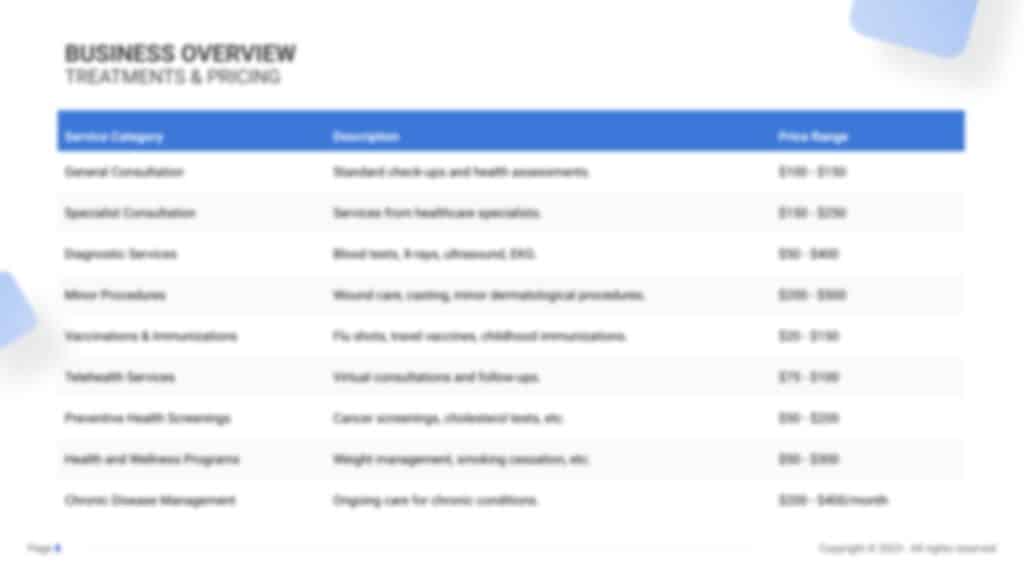
Market Overview

Industry size & growth
In the Market Overview of your veterinary clinic business plan, begin by assessing the size of the veterinary services industry and its growth potential. This analysis is essential to grasp the market’s breadth and pinpoint opportunities for expansion.
Key market trends
Move on to discuss recent market trends, such as the growing consumer interest in comprehensive pet care, the demand for specialized veterinary services, and the adoption of advanced medical technologies. For instance, highlight the demand for services that address specific pet health issues, alongside the increasing popularity of clinics offering holistic and alternative treatments.
Competitive Landscape
A competitive analysis is not just a tool for gauging the position of your veterinary clinic in the market and its key competitors; it’s also a fundamental component of your business plan. This analysis helps identify your veterinary clinic’s unique selling points, essential for differentiating your business in a competitive market.
In addition, competitive analysis is integral in laying a solid foundation for your business plan. By examining various operational aspects of your competitors, you gain valuable information that ensures your business plan is robust, informed, and tailored to succeed in the current market environment.
Identifying Your Competitors in the Veterinary Industry
Initiate the analysis by identifying both direct and indirect competitors. Direct competitors may include other veterinary clinics within your immediate vicinity, offering similar services and specialties. However, don’t disregard indirect competitors like pet grooming services, online pet healthcare platforms, or even holistic pet care centers, as they cater to similar pet owners’ needs.
Leverage online resources such as Google Maps, Yelp, or specialized directories to map out the locations and gather insights into your competitors. Analyze customer reviews and ratings to discern competitor strengths and weaknesses. For instance, if “Paws & Claws Veterinary Care” receives commendations for its emergency care services, this signifies a competitive strength you can assess and potentially improve upon in your clinic.
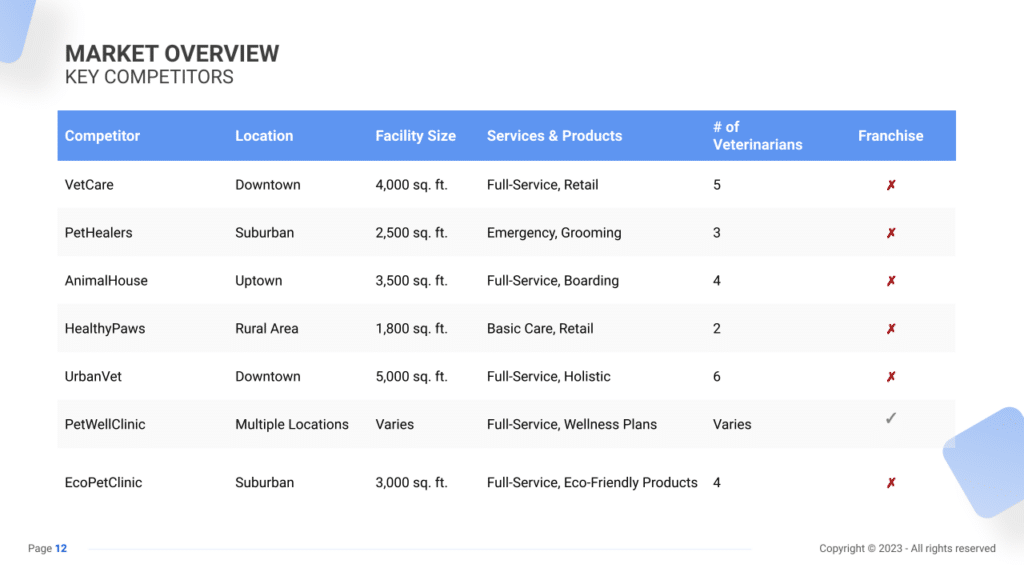
Veterinary Clinic Competitors’ Strategies
Analyzing competitors involves scrutinizing multiple facets:
- Services Offered: Evaluate the spectrum of services provided by competitors. If a rival clinic emphasizes alternative therapies like acupuncture or offers specialized dental care, this might hint at emerging trends or niche services gaining traction in the market.
- Technological Advancements: Consider technological integrations and innovations in practice. A clinic like “Modern Pet Wellness” utilizing telemedicine or digital records may appeal to a different segment compared to a clinic focusing solely on traditional treatment methods.
- Pricing Models: Compare pricing structures to ascertain whether your clinic’s fees align with the market average or if there’s potential to differentiate based on pricing, perhaps by offering bundled service packages or discounts for regular clients.
- Marketing Strategies: Analyze how competitors market their services. Do they heavily invest in online advertising and community events, or rely on client referrals and testimonials?
- Client Experience: Assess the overall client experience provided by competitors. For instance, a clinic renowned for its warm, welcoming atmosphere and personalized pet care can gain a competitive edge based on exceptional client satisfaction.
- Operational Efficiency: Observe if competitors utilize efficient administrative systems or technological tools to enhance operational efficiency, such as appointment scheduling apps or automated reminders.
What’s Your Clinic’s Value Proposition?
Reflect on your veterinary clinic’s unique value proposition. Perhaps your clinic specializes in exotic pet care, offers comprehensive wellness plans, or is recognized for its compassionate end-of-life care services.
Identify gaps in the market by considering customer feedback and staying abreast of industry trends. For example, the rising demand for integrative medicine or holistic pet care could represent an opportunity if competitors are not meeting this burgeoning need.
Additionally, tailor your clinic’s approach based on the location and community demographics. A clinic in a suburban area might focus on family-centric services, while one in an urban setting might prioritize convenience and extended operating hours.
Strategy

SWOT
First, perform a SWOT analysis for the veterinary clinic, identifying Strengths (such as experienced veterinary staff and comprehensive care services), Weaknesses (including potential high operational costs or significant competition), Opportunities (for instance, a growing trend in pet ownership and preventive healthcare), and Threats (such as economic downturns that may reduce spending on non-essential pet services).
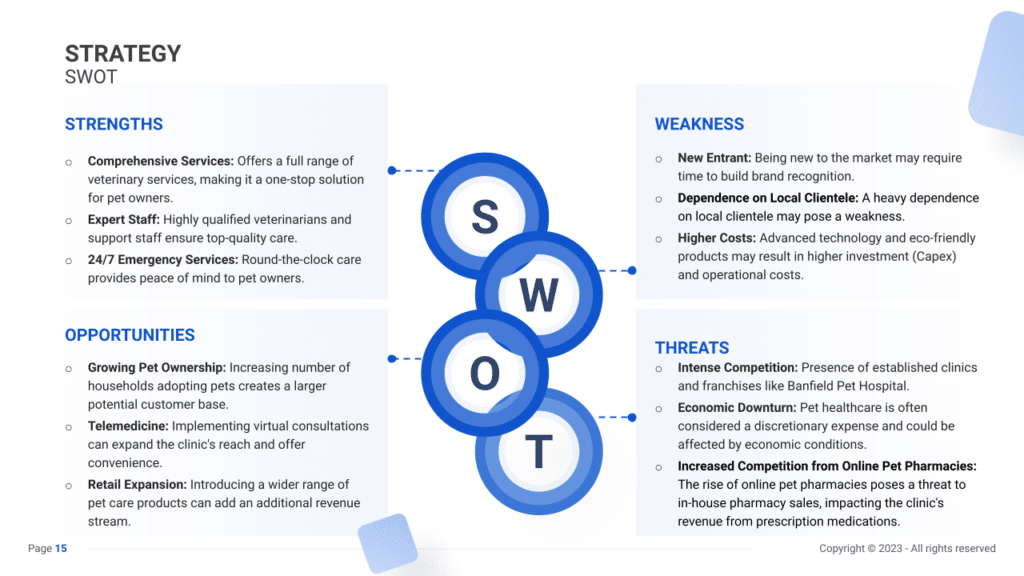
Marketing Plan
Next, devise a marketing strategy that details methods to attract and retain pet owners through targeted advertising, promotional offers, an active online presence, and engagement with the local community.
Marketing Channels
Utilize various marketing channels to reach pet owners and create awareness about your veterinary clinic’s services.
Digital Marketing
Leverage digital platforms to engage with pet owners:
- Social Media: Utilize platforms like Facebook, Instagram, Twitter, and TikTok to share pet health tips, success stories, behind-the-scenes glimpses, and client testimonials. Engage with your audience through interactive posts, stories, and live sessions.
- Website and SEO: Develop a user-friendly website highlighting your services, team expertise, client testimonials, and educational content. Optimize your website for local SEO to improve visibility in search engine results.
- Email Marketing: Build an email list by offering valuable content, such as newsletters containing pet care advice, promotions, and updates about your clinic’s services and events. Use personalized and informative emails to nurture client relationships.
Local Advertising
Connect with the local community:
- Community Events: Participate in local pet adoption drives and pet expos, or sponsor animal-related charity events to showcase your clinic’s involvement and commitment to animal welfare.
- Local Partnerships: Collaborate with pet stores, dog groomers, or animal shelters for cross-promotional opportunities. Offer educational seminars or workshops on pet care in partnership with local businesses.
Promotional Activities
Engage pet owners with attractive offers:
- First Visit Discounts: Offer discounts on initial consultations or vaccinations to attract new clients to your clinic.
- Referral Programs: Incentivize existing clients to refer friends and family by offering discounts on future services or a free pet wellness check-up.
- Seasonal Promotions: Introduce seasonal campaigns like ‘Spring Pet Wellness Check-ups’ or ‘Summer Flea & Tick Prevention Packages’ to address timely pet health concerns.
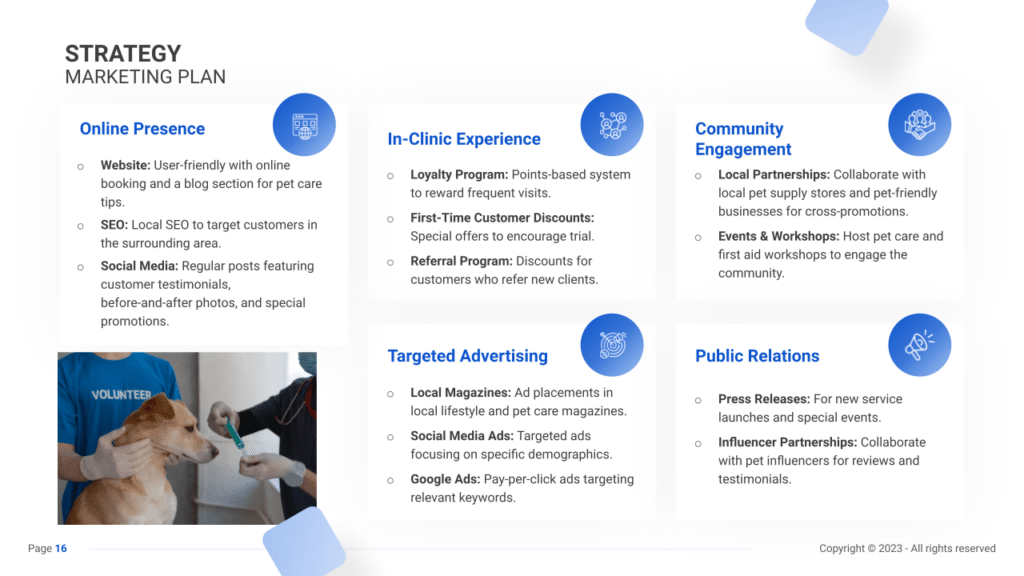
Sales Channels
Maximize revenue streams and enhance the customer experience through effective sales channels.
In-Clinic Upselling
Offer additional services or products during appointments:
- Preventive Care Packages: Suggest comprehensive wellness packages covering vaccinations, flea and tick treatments, and routine check-ups for cost-effective pet care.
- Retail Products: Display pet care products and supplements in your clinic and educate clients on their benefits. Provide recommendations for at-home pet care routines.
Online Booking and Sales
Provide convenience and accessibility to clients:
- Online Appointment Booking: Implement an easy-to-use online booking system via your website or social media platforms to schedule appointments efficiently.
- E-Commerce: Sell pet care products, prescription refills, and specialty foods online through your website or a dedicated online store.
- Telemedicine: Offer virtual consultations for minor pet health concerns, advice on pet behavior, and follow-up appointments for convenience and extended reach.
Membership and Loyalty Programs
Encourage client loyalty and recurring visits:
- Pet Health Memberships: Introduce membership plans offering discounted or bundled services, including regular check-ups, vaccinations, and dental cleanings. These plans can encourage pet owners to commit to ongoing care for their pets.
- Loyalty Rewards: Establish a digital loyalty program where clients earn points or rewards for each visit, redeemable for discounts on services or products. Rewarding loyal clients can foster long-term relationships and repeat visits.
Strategy Timeline
Finally, establish a detailed timeline that outlines key milestones for the veterinary clinic’s launch, marketing initiatives, client base development, and growth goals, ensuring the business progresses with clarity and intent.

Management
The Management section focuses on the veterinary clinic’s management and their direct roles in daily operations and strategic direction. This part is crucial for understanding who is responsible for making key decisions and driving the veterinary clinic towards its financial and operational goals.
For your veterinary clinic business plan, list the core team members, their specific responsibilities, and how their expertise supports the business.


Financial Plan
The Financial Plan section is a comprehensive analysis of your financial projections for revenue, expenses, and profitability. It lays out your veterinary clinic’s approach to securing funding, managing cash flow, and achieving breakeven.
This section typically includes detailed forecasts for the first 5 years of operation, highlighting expected revenue, operating costs and capital expenditures.
For your veterinary clinic business plan, provide a snapshot of your financial statement (profit and loss, balance sheet, cash flow statement), as well as your key assumptions (e.g. number of customers and prices, expenses, etc.).
Make sure to cover here
_ Profit and Loss
_ Cash Flow Statement
_ Balance Sheet
_ Use of Funds









